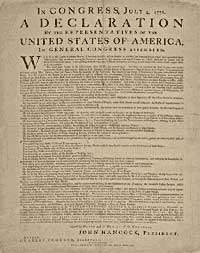10g. The Declaration of Independence

The moment had finally come. Far too much bad blood existed between the colonial leaders and the crown to consider a return to the past. More and more colonists felt deprived by the British not only of their money and their civil liberties, but their lives as well. Bloodshed had begun over a year ago and there seemed little chance of a ceasefire. The radical wing of the Continental Congress was gaining strength with each passing day. It was time for a formal break with mother England. It was time to declare independence.
On June 7, 1776, Richard Henry Lee introduced a resolution to the Congress that declared the thirteen colonies "free and independent states." Congress did not act on the resolution immediately. A vote was set for early July. In the meantime it seemed appropriate that some sort of explanation was in order for such a bold act. A subcommittee of five, including Benjamin Franklin, John Adams and Thomas Jefferson, was selected to choose the careful wording. Such a document must be persuasive to a great many parties. Americans would read this and join the patriot cause. Sympathetic Britons would read this and urge royal restraint. Foreign powers would read this and aid the colonial militia. They might, that is, if the text were convincing. The five agreed that Jefferson was the most talented writer. They would advise on his prose.
The declaration is divided into three main parts. The first was a simple statement of intent. Jefferson's words echo down through the decades of American life until the present day. Phrases like "all men are created equal," "unalienable rights," and "life, liberty, and pursuit of happiness" have bounced from the lips of Americans in grammar school and retirement. All are contained in the first section that outlines the basic principles of the enlightened leaders. The next section is a list of grievances; that is, why the colonies deemed independence appropriate. King George was guilty of "repeated injuries" that intended to establish "absolute tyranny" in North America. He has "plundered our seas, burned our towns, and destroyed the lives of our people." It was difficult for Americans to argue his points. The concluding paragraph officially dissolves ties with Britain. It also shows modern readers the courage taken by each delegate who would sign. They were now officially guilty of treason and would hang in the gallows if taken before a royal court. Thus, they would "pledge to each other our lives, our fortunes, and our sacred honor."
Debate in the Congress followed. Jefferson watched painfully as the other delegates tweaked his prose. Jefferson had wanted to include a passage blaming the king for the slave trade, for example, but the southern delegates insisted upon its removal. Finally on July 4, 1776, the colonies approved the document. The vote was twelve to zero, with the New York delegation abstaining. As president of the Congress, John Hancock scrawled his famous signature across the bottom and history was made. If the American effort was successful, they would be hailed as heroes. If it failed, they would be hanged as traitors.





